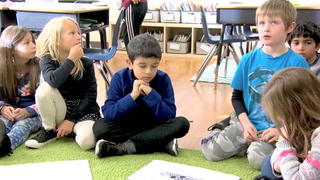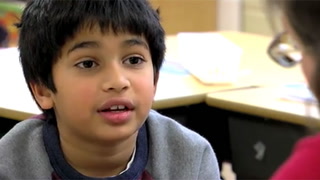Scientific Argumentation in the Early Grades Transcript
Card:
Tch
TeachingChannel
+++ 00:00:05 +++
Kitten Vaa: So, we’ve been investigating the town of Moncton and we’ve been wondering and investigating the question “What caused the town of Moncton to flood?”
Card:
Scientific Argumentation in the Early Grades:
6 Instructional Principles
Card:
How does it look like when 2nd grade students engage in scientific argumentation?
+++ 00:00:29 +++
Students: The soil was faster, so the water could go through the glacier moraine to the town of Moncton.
Kitten Vaa: So, I heard there’s a claim and I heard some evidence. Can someone-- do you want-- can I have someone repeat what you heard? What was the general claim that you heard?
Lower third:
Jessica Thompson
Professor of Science Education
University of Washington, Seattle WA
+++ 00:00:52 +++
Jessica Thompson: What you see in the video is young kids weighing multiple hypotheses, checking each other, doing some fact checks, and trying to get to the heart of “What part of my statement do you agree or disagree with?”
Card:
Jennifer Richards
Research Associate
University of Washington, Seattle WA
Jennifer Richards: The project that we are working on is really thinking about what certain scientific practices that are central NGSS look like when working in primary classrooms. So, in grades kindergarten through second grade.
+++ 00:01:17 +++
Kitten Vaa: What claim did you hear?
Student: I heard that if the glacier is mostly sand and some pebbles in the mountain--
Kitten Vaa: Then--?
Student: --then the water would go slower?
Kitten Vaa: Then the water would go slower. Do you agree or disagree?
Student: Agree.
Kitten Vaa: Can you tell me more?
Student: Because when we did the experiment with earth materials and we used sand, it went slower than soil, like, pebbles.
+++ 00:01:44 +++
Student: I kind of want to add on. Yeah, I want to add on to Jamie’s. I agree with it is very compact and it has little tiny spaces in between for the water to go through, but I really think that sand went the slowest because sand has the most littlest things in it.
+++ 00:02:10 +++
Jessica Thompson: This video looks at a whole unit of construction and how teachers can support scientific argumentation inside of modeling at the beginning, middle, and end of a unit. And how do we support kids when agreeing and disagreeing with one another?
Card:
How do we develop a culture of scientific argumentation in our classrooms?
6 instructional principles
Card:
Principle 1
Elicit students’ ideas from their initial models about a puzzling phenomenon
+++ 00:02:37 +++
Kitten Vaa: We started with drawing our initial models and talking about our own ideas and personal experiences about what we think caused the town to flood.
Lower third:
Beginning of Unit/Teacher Video
Kitten Vaa: At the beginning of the unit the students are presented with the phenomena and they’re given a model to be thinking about how and why the town had flooded.
Card:
Kitten Vaa
2nd Grade Teacher
Brighton School, Mountlake Terrace WA
Kitten Vaa: And, so, as a teacher I’m listening to students’ ideas, listening to their own language that they’re bringing.
+++ 00:03:06 +++
Students: His idea was that water was-- could go-- was going through the ground and then there was, like, the layer of stone over here. And then the water kept on rising up.
Student: Our model is that maybe the dam exploded because there’s such a powerful water current.
+++ 00:03:28 +++
Kitten Vaa: Their initial models don’t necessarily have a lot of writing, so it’s important that you’re listening to the student’s ideas.
Card:
Principle 2
Identify initial claims from students’ ideas
+++ 00:03:37 +++
Kitten Vaa: Yesterday, you shared your initial ideas of what you think might be happening that’s causing the flood for the town of Moncton. And, so, I have three claims that I want to share with you and I want you to think about them to yourself on whether you agree or whether you would like to make any changes or if you like them just the way they are. So, one of the claims we had is it says, “We claim that the water
+++ 00:04:06 +++
filled up behind the dam and went up the hill and then down to the town.” And, so, I have made copies of the models that showed that idea.
+++ 00:04:18 +++
Kitten Vaa: Once I had seen those patterns we presented the claims and asked students to see if they agreed or disagreed with those claims, if they wanted to make any revisions, and had their models where we felt it represented those claims.
+++ 00:04:36 +++
Kitten Vaa: So, she was saying this model should be over here.
Student: Yeah.
Kitten Vaa: Are you agreeing with that? So, this model was in the wrong section.
+++ 00:04:45 +++
Jennifer Richards: I think there are a few considerations that are important in selecting key claims at the beginning of a unit that’s to anchor modeling and really explaining a phenomenon. The first step that Kitten engaged in was really looking at the range of student models when they first initially thought about what caused the town of Moncton to flood. And, so, she was trying to select out what are some of the ideas she’s seen across models that were common, that were familiar to the students, and that also represented a range of perspectives that they’d be able to pursue together over time.
Card:
Principle 3
Value students’ experiences as evidence to start agreeing/disagreeing with the claims
+++ 00:05:20 +++
Jennifer Richards: Kids come in with a range of really productive and sensible ideas and experiences from their lives. Even young students are coming in with a wealth of experiences. And those are what are particularly generative for supporting their sense-making.
+++ 00:05:36 +++
Kitten Vaa: Share your idea again and I want everyone to think about where does this idea go, this personal experience. So, hold on, put your hands down and let-- share that story one more time.
Student: So, me and Andrew were using those tools and we pushed the water off the concrete and, so, then it soaked inside the soil.
Kitten Vaa: So, this is an idea that would agree and support this claim. Okay? We might have some that you would disagree and have some kind of experience that would say, “That can’t happen.”
Card:
Principle 4
Revisit the Agree/Disagree T-charts with evidence throughout the unit
+++ 00:06:22 +++
Kitten Vaa: So, we use the claim T-charts to collect evidence and thinking about the evidence that we are using whether it proves or disproves that claim. Then as students built their knowledge they started using other pieces of evidence in the experiments that they’ve done, the videos that we were watching, the texts that we were reading. And, so, building that over time students became more confident in their science ideas. Some students changed their science ideas because of those experiences.
Lower third:
Middle of Unit/Teacher Video
+++ 00:06:55 +++
Kitten Vaa: We’re going to be shopping for evidence today and you’re going to be thinking about these two claims and whether they help support or disprove these ideas.
+++ 00:07:05 +++
Jessica Thompson: They make claims at the beginning of a unit and then they constantly revise them over time. And they’re amounting evidence and weighing evidence throughout the entire units, but it’s all done within the drawing of a scientific model. And they’re constantly revisiting and drawing what they can see and what they can’t see happening.
Card:
Principle 5
Use models to press for connections between evidence and causal reasoning
+++ 00:07:28 +++
Kitten Vaa: Tell me your claim again?
Student: If the glacier left mostly sand and some rocks in the mountain, then the water would go slower to the town because sand collects the water when the water
Kitten Vaa: Do you agree with that? So, the next step is I want you to be thinking about evidence. We’ve been talking about evidence. And, so, how do we know that? So, “I know this because--”
+++ 00:07:55 +++
Kitten Vaa: And what I’m hearing you say is that because they’re so close together that it’s slowing it down to-- so, making it go slower. Is there an example where we saw that because it wasn’t so close together that it went faster? Was there a different material that--?
Student: Well, I think it was with the pebbles.
Kitten Vaa: So, we can look to see, too, right? So, was that--?
Student: The pebbles-- well, let’s see-- clay was one hundred.
Kitten Vaa: Did that take longer or shorter amount of time?
Student: Longer.
Kitten Vaa: Yeah.
+++ 00:08:29 +++
Jessica Thompson: They’re usually modeling an argumentation together and in that way these practices co-develop where they get to get better at scientific modeling and drawing what they can see and what they can’t see along with developing much richer scientific claims over time.
Card:
Principle 6
Continuously work on discussion norms to build community
+++ 00:08:49 +++
Kitten Vaa: We do a lot of thinking about how scientists it’s not just usually one person, and that it is a group of people working together as a community. And, so, we spend a lot of time at the beginning of the year talking about what does that look like? And what does that sound like? It’s not quick at all. Yeah, it takes time.
+++ 00:09:09 +++
Kitten Vaa: So, what are you hearing Jamie say?
Student: I heard Jamie say that he thought that the sand was going to-- I actually can’t remember now.
Kitten Vaa: So, what can you do?
Student: Can you please repeat it, Jamie?
Jamie: I agree with Nick’s idea, because the sand is more packed together than the pebbles. There aren’t as many hole in the sand.
Student: And I agree with that idea.
+++ 00:09:39 +++
Kitten Vaa: I feel like they’ve changed in having the confidence of being able to share their thinking and agreeing and disagreeing comfortably. I see them now challenging each other and thinking about the ideas that they share and asking really good questions that are clarifying what do they mean by that.
+++ 00:10:00 +++
Kitten Vaa: I want to thank you for sharing and taking a stand today and we’ll continue thinking more. Yes. And we’ll continue thinking more about what’s causing this. So, nice job today. Thank you.
Card:
Principle 1: Elicit students’ ideas from their initial models about a puzzling phenomenon
Principle 2: Identify initial claims from students’ ideas
Principle 3: Value students’ experiences as evidence to start agreeing/disagreeing with the claims
Principle 4: Revisit the Agree/Disagree T-charts with evidence throughout the unit
Principle 5: Use models to press for connections between evidence and causal reasoning
Principle 6: Continuously work on discussion norms to build community
Card:
Tch
TeachingChannel














10 Comments
Avery Baird May 17, 2020 7:44pm
I like how this teacher has the students read their answers aloud then asks their peers about what they said, this keeps each student engaged. I also think the way she has the students look at the lesson and claims over and over in a few different ways really gets their mind going that there can be different answers and experiences. She did a great job of encouraging the students to revise and make changes if needed which requires the students to use their critical thinking skills. The language these kids were using was also amazing, they were answering each other, agreeing or disagreeing in an advanced way and that was really great to see.
Mary Bartz Mar 1, 2019 1:36am
Like all the learning that is going on and the data collection to prove ones thoughts!
Anna Beck Apr 27, 2018 6:19pm
Alysia Kinkel Nov 21, 2017 11:23pm
Michelle Ho May 20, 2017 12:43pm